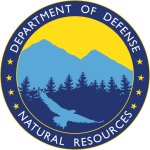Congress established the Sikes Act (16 U.S.C. 670a- 670o) in 1960 to ensure that DoD conserves and protects the natural resources they use. Because military lands often are protected from human access and impact, they contain some of our nation’s most significant remaining large tracts of valuable natural resources. In 1997, Congress amended the Sikes Act to require DoD to develop and implement Integrated Natural Resources Management Plans (INRMPs) to outline how each military installation with significant natural resources will manage those resources.
INRMPs are planning documents that outline how each military installation with significant natural resources will manage those resources. They integrate military mission requirements, environmental and master planning documents, cultural resources, and outdoor recreation to ensure both military operations and natural resources conservation are included and consistent with stewardship and legal requirements. INRMPs require installations to look holistically at natural resources on a landscape or ecosystem basis. They are living documents that provide direction for daily natural resources management activities, and they provide a foundation for sustaining military readiness.
INRMPs are based on the principles of ecosystem management. They describe how to manage natural resources, allow for multipurpose uses of those resources, and define public access—all while ensuring no net loss in the capability of an installation to support its military testing and training mission.
Although variations exist among the different Military Services, a basic INRMP includes:
- A description of the installation, its history, and its current mission;
- Management goals and associated timeframes;
- Projects to be implemented and estimated costs;
- A discussion of how the military mission and training requirements are supported while protecting the environment;
- Natural resources’ biological needs and legal requirements;
- The role of the installation’s natural resources in the context of the surrounding ecosystem;
- Input from the U.S. Fish & Wildlife Service (USFWS), state fish and wildlife agency, and the general public.
All installations must keep their INRMPs current. INRMPs undergo an annual internal review, and are updated or revised as necessary. Installations invite the USFWS and the appropriate state agency to participate in the annual review process. In addition to DoD’s annual review policy, the Sikes Act requires that USFWS and state formally review INRMPs for operation and effect at least every five years.
The INRMP planning process integrates all traditional elements of natural resources management. The process also considers military mission requirements, installation master planning, environmental planning, and outdoor recreation. To address installation requirements and regional issues, INRMPs involve appropriate stakeholders, thereby providing for more efficient and effective management of natural resources on a landscape-scale basis, all while ensuring that military readiness is sustained.
To see deliverables resulting from fully executed Legacy projects, visit the Legacy Project Deliverables page: https://www.denix.osd.mil/legacy/nr-legacy-project-deliverables/

Guidance
DoD Manual 4715.03, INRMP Implementation Manual
Climate Adaptation for DoD Natural Resource Managers

